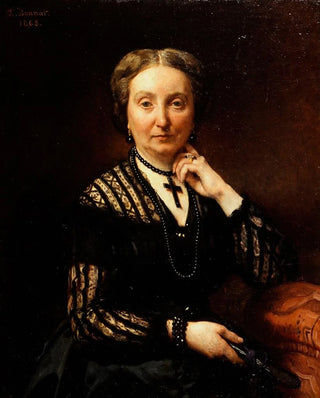Art print | Portrait of a Woman - Léon Bonnat


View from behind

Frame (optional)
Portrait of a Woman - Léon Bonnat – Captivating Introduction
The "Portrait of a Woman" by Léon Bonnat is an iconic artwork that captures the very essence of feminine beauty through the lens of realism. This painting, created at the end of the 19th century, demonstrates rare technical mastery and artistic sensitivity that transcend eras. Gazing upon this piece, the viewer is immediately transported into a universe where light and shadow dance across the delicate face of the depicted woman. The finely detailed features, combined with a subtly nuanced color palette, create an atmosphere that is both intimate and universal, inviting reflection on the feminine condition and the art of portraiture.
Style and uniqueness of the work
The uniqueness of the "Portrait of a Woman" lies in Bonnat's ability to capture not only the external appearance of his model but also her soul. The carefully balanced composition highlights the woman's face, whose eyes seem to follow the viewer, establishing a powerful emotional connection. The meticulous details, from the rendering of the hair to the nuances of the skin, reveal exceptional attention to texture and light. Bonnat employs chiaroscuro techniques that enhance volume and depth, giving his subject an almost palpable presence. This painting, far from being a simple representation, becomes a celebration of femininity, an ode to timeless beauty and the complexity of human emotions.
The artist and his influence
Léon Bonnat, born in 1833, is a prominent figure in French academic painting. His artistic journey, marked by success, allowed him to associate with the greatest masters of his time. Influenced by realism and romanticism, Bonnat developed a unique style that combines technical rigor with sensitivity. His portraits, often commissioned by the elite of his era, demonstrate a deep psychological understanding of his models. The artist also played a vital role in training many painters, sharing his expertise and love of art through teaching. His legacy endures, inspiring contemporary artists who seek to explore the nuances of human representation.
An exceptional wall decoration signed

Matte finish

View from behind

Frame (optional)
Portrait of a Woman - Léon Bonnat – Captivating Introduction
The "Portrait of a Woman" by Léon Bonnat is an iconic artwork that captures the very essence of feminine beauty through the lens of realism. This painting, created at the end of the 19th century, demonstrates rare technical mastery and artistic sensitivity that transcend eras. Gazing upon this piece, the viewer is immediately transported into a universe where light and shadow dance across the delicate face of the depicted woman. The finely detailed features, combined with a subtly nuanced color palette, create an atmosphere that is both intimate and universal, inviting reflection on the feminine condition and the art of portraiture.
Style and uniqueness of the work
The uniqueness of the "Portrait of a Woman" lies in Bonnat's ability to capture not only the external appearance of his model but also her soul. The carefully balanced composition highlights the woman's face, whose eyes seem to follow the viewer, establishing a powerful emotional connection. The meticulous details, from the rendering of the hair to the nuances of the skin, reveal exceptional attention to texture and light. Bonnat employs chiaroscuro techniques that enhance volume and depth, giving his subject an almost palpable presence. This painting, far from being a simple representation, becomes a celebration of femininity, an ode to timeless beauty and the complexity of human emotions.
The artist and his influence
Léon Bonnat, born in 1833, is a prominent figure in French academic painting. His artistic journey, marked by success, allowed him to associate with the greatest masters of his time. Influenced by realism and romanticism, Bonnat developed a unique style that combines technical rigor with sensitivity. His portraits, often commissioned by the elite of his era, demonstrate a deep psychological understanding of his models. The artist also played a vital role in training many painters, sharing his expertise and love of art through teaching. His legacy endures, inspiring contemporary artists who seek to explore the nuances of human representation.
An exceptional wall decoration signed






